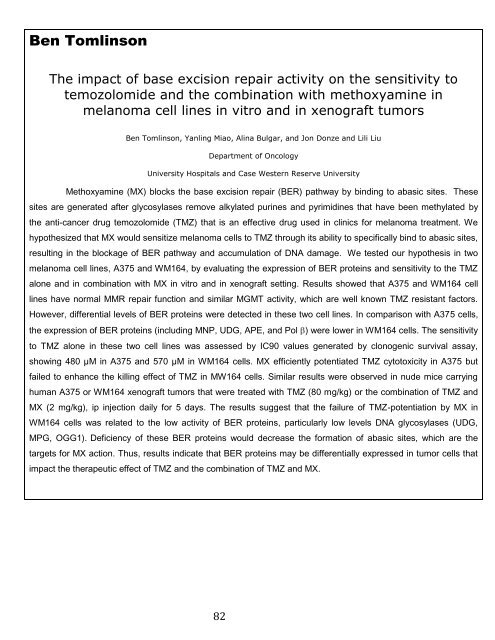student research day - Case Western Reserve University School of ...
student research day - Case Western Reserve University School of ...
student research day - Case Western Reserve University School of ...
You also want an ePaper? Increase the reach of your titles
YUMPU automatically turns print PDFs into web optimized ePapers that Google loves.
Ben Tomlinson<br />
The impact <strong>of</strong> base excision repair activity on the sensitivity to<br />
temozolomide and the combination with methoxyamine in<br />
melanoma cell lines in vitro and in xenograft tumors<br />
Ben Tomlinson, Yanling Miao, Alina Bulgar, and Jon Donze and Lili Liu<br />
Department <strong>of</strong> Oncology<br />
<strong>University</strong> Hospitals and <strong>Case</strong> <strong>Western</strong> <strong>Reserve</strong> <strong>University</strong><br />
Methoxyamine (MX) blocks the base excision repair (BER) pathway by binding to abasic sites. These<br />
sites are generated after glycosylases remove alkylated purines and pyrimidines that have been methylated by<br />
the anti-cancer drug temozolomide (TMZ) that is an effective drug used in clinics for melanoma treatment. We<br />
hypothesized that MX would sensitize melanoma cells to TMZ through its ability to specifically bind to abasic sites,<br />
resulting in the blockage <strong>of</strong> BER pathway and accumulation <strong>of</strong> DNA damage. We tested our hypothesis in two<br />
melanoma cell lines, A375 and WM164, by evaluating the expression <strong>of</strong> BER proteins and sensitivity to the TMZ<br />
alone and in combination with MX in vitro and in xenograft setting. Results showed that A375 and WM164 cell<br />
lines have normal MMR repair function and similar MGMT activity, which are well known TMZ resistant factors.<br />
However, differential levels <strong>of</strong> BER proteins were detected in these two cell lines. In comparison with A375 cells,<br />
the expression <strong>of</strong> BER proteins (including MNP, UDG, APE, and Pol ) were lower in WM164 cells. The sensitivity<br />
to TMZ alone in these two cell lines was assessed by IC90 values generated by clonogenic survival assay,<br />
showing 480 µM in A375 and 570 µM in WM164 cells. MX efficiently potentiated TMZ cytotoxicity in A375 but<br />
failed to enhance the killing effect <strong>of</strong> TMZ in MW164 cells. Similar results were observed in nude mice carrying<br />
human A375 or WM164 xenograft tumors that were treated with TMZ (80 mg/kg) or the combination <strong>of</strong> TMZ and<br />
MX (2 mg/kg), ip injection daily for 5 <strong>day</strong>s. The results suggest that the failure <strong>of</strong> TMZ-potentiation by MX in<br />
WM164 cells was related to the low activity <strong>of</strong> BER proteins, particularly low levels DNA glycosylases (UDG,<br />
MPG, OGG1). Deficiency <strong>of</strong> these BER proteins would decrease the formation <strong>of</strong> abasic sites, which are the<br />
targets for MX action. Thus, results indicate that BER proteins may be differentially expressed in tumor cells that<br />
impact the therapeutic effect <strong>of</strong> TMZ and the combination <strong>of</strong> TMZ and MX.<br />
82
















